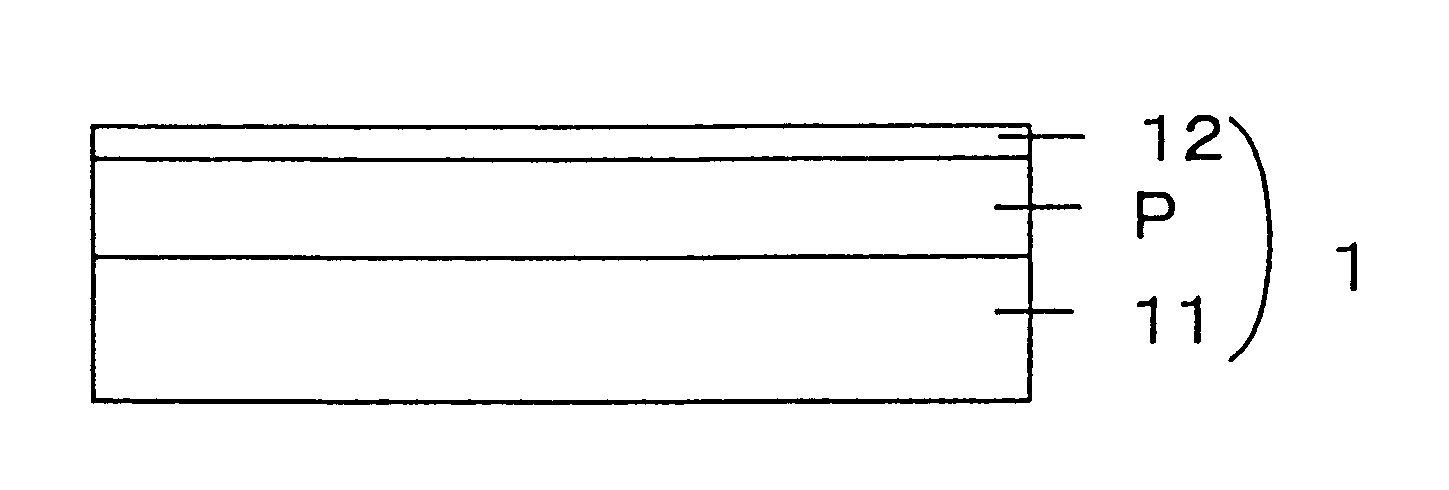Transparent conductive film and touch panel
a technology of transparent conductive film and touch panel, which is applied in the manufacture of butter, conductive layers on insulating supports, synthetic resin layered products, etc., can solve the problems of etching characteristics of transparent conductive thin film at the time of touch panel production, and the conventional transparent conductive film has the problems, and achieves excellent durability to input with a pen.
- Summary
- Abstract
- Description
- Claims
- Application Information
AI Technical Summary
Benefits of technology
Problems solved by technology
Method used
Image
Examples
example 1
A polyester resin (VYLON RV280 available from Toyobo Co., Ltd.; the amount of ionic group, 120 eq / ton) and an isocyanate cross-linking agent (CORONATE L available from Nippon Polyurethane Industry Co., Ltd.) were mixed with methyl ethyl ketone and toluene as solvents in the mixing ratio shown in Table 1 to give a coating solution. The coating solution prepared was then coated on a polyester resin film (COSMOSHINE A4350 available from Toyobo Co., Ltd.) of 188 .mu.m in thickness by the bar coat method. Wire bar No. 3 was used. The coated film was subjected to heat treatment at 130.degree. C. for 30 minutes. The coating thickness was 0.3 .mu.m.
On the coating side of the coated plastic film, an indium-tin composite oxide thin film of 250 .ANG. in thickness having 5 wt % tin oxide content was formed as a transparent conductive thin film by the DC magnetron sputtering method using an indium-tin composite oxide as a target. At that time, the degree of vacuum was set to 1.times.10.sup.-3 To...
example 2
A polyester resin (VYLON RV280 available from Toyobo Co., Ltd.; the amount of ionic group, 50 eq / ton) and an isocyanate cross-linking agent (CORONATE L available from Nippon Polyurethane Industry Co., Ltd.) were mixed with methyl ethyl ketone and toluene as solvents in the mixing ratio shown in Table 1 to give a coating solution. The coating solution prepared was then coated on a polyester resin film (COSMOSHINE A4350 available from Toyobo Co., Ltd.) of 188 .mu.m in thickness by the bar coat method. Wire bars Nos. 3 and 6 were used. The coated films were subjected to heat treatment at 130.degree. C. for 30 minutes. The coating thickness was 0.12 or 0.25 .mu.m.
On the coating side of each of the coated plastic films, an indium-tin composite oxide thin film of 250 .ANG. in thickness having 5 wt % tin oxide content was formed as a transparent conductive thin film by the DC magnetron sputtering method using an indium-tin composite oxide as a target. At that time, the degree of vacuum was...
example 3
A polyester resin (VYLON RV285 available from Toyobo Co., Ltd.; the amount of ionic group, 340 eq / ton) and an isocyanate cross-linking agent (CORONATE L available from Nippon Polyurethane Industry Co., Ltd.) were mixed with methyl ethyl ketone and toluene as solvents in the mixing ratio shown in Table 1 to give a coating solution. The coating solution prepared was then coated on a polyester resin film (COSMOSHINE A4350 available from Toyobo Co., Ltd.) of 188 .mu.m in thickness by the bar coat method. Wire bar No. 3 was used. The coated film was subjected to heat treatment at 130.degree. C. for 30 minutes. The coating thickness was 0.12 .mu.m.
On the coating side of the coated plastic film, an indium-tin composite oxide thin film of 300 .ANG. in thickness having 10 wt % tin oxide content was formed as a transparent conductive thin film by the DC magnetron sputtering method using an indium-tin composite oxide as a target. At that time, the degree of vacuum was set to 1.times.10.sup.-3 ...
PUM
| Property | Measurement | Unit |
|---|---|---|
| Surface energy | aaaaa | aaaaa |
| Mass | aaaaa | aaaaa |
| Mass | aaaaa | aaaaa |
Abstract
Description
Claims
Application Information
 Login to View More
Login to View More - R&D
- Intellectual Property
- Life Sciences
- Materials
- Tech Scout
- Unparalleled Data Quality
- Higher Quality Content
- 60% Fewer Hallucinations
Browse by: Latest US Patents, China's latest patents, Technical Efficacy Thesaurus, Application Domain, Technology Topic, Popular Technical Reports.
© 2025 PatSnap. All rights reserved.Legal|Privacy policy|Modern Slavery Act Transparency Statement|Sitemap|About US| Contact US: help@patsnap.com



